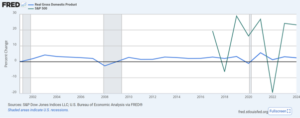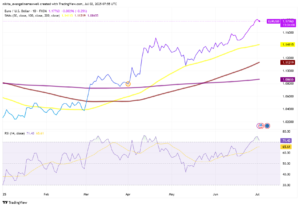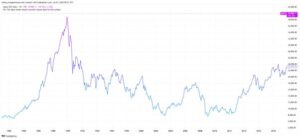Significant Decline in Gold Imports
China’s net gold imports through Hong Kong fell by 4.6% in October compared to the previous month and plummeted by 43% year-over-year, according to data released by Hong Kong's Census and Statistics Department. This steep decline underscores the impact of reduced domestic demand for gold jewelry and a slow economic recovery in China.
While demand for investment-grade gold items such as bars and coins remains relatively stable, the appetite for adornment jewelry has dropped considerably. This has created a pricing disconnect, with Shanghai gold prices frequently trading at a discount to international prices. For much of October, the Shanghai price was lower than the global market by over $20 on several trading days, incentivizing traders to export gold and profit from the price differential.
Retail Sector Suffers Significant Losses
The weak demand for gold jewelry has had a severe impact on retailers in China. Chow Tai Fook Jewellery Group, the nation’s largest jewelry retailer, reported a 20.4% revenue decline for the six months ending in September, marking the sharpest drop for this period since 2016. The company’s profit fell by 44.4%, primarily due to losses from revaluation of gold loan contracts amid volatile prices.
In response to these challenges, Chow Tai Fook announced plans to repurchase up to HK$2 billion worth of shares to reinforce confidence in its long-term prospects. However, the company continues to face headwinds from weak consumer confidence caused by plunging property prices and high unemployment. Rising gold prices have further deterred purchases, especially for adornment jewelry. Additionally, the slow recovery of Hong Kong’s tourism sector—an important market for luxury goods—has compounded the challenges.
Same-store sales in mainland China dropped by 25.4%, while sales in Hong Kong and Macau fell by 30.8%. To manage profitability, the company reduced its store network by 239 outlets, mainly franchised ones.
Other Retailers Face Similar Challenges
Luk Fook Holdings, another major jewelry retailer, has also experienced substantial losses. The company closed 175 stores across China and Hong Kong during the six months ending in September, citing record-high gold prices as a key factor affecting revenue.
Luk Fook’s revenue dropped 27% year-over-year to HK$5.45 billion, while its net profit declined by 56% due to losses from gold hedging. The company noted that its weaker performance was partly due to a strong rebound in the luxury sector in the same period last year following the reopening of borders with mainland China.
Sales in Hong Kong, Macau, and overseas markets fell by 27%, while same-store sales declined by 35%. Gold and platinum product sales dropped by 37%, and fixed-price jewelry items, including diamonds, fell by 30%. Mainland China sales also decreased by 27% during this period.
Key Factors Behind Declining Demand
Several factors are driving the sharp drop in demand for gold in China:
- Economic Headwinds: A sluggish domestic economic recovery, falling property prices, and high unemployment have eroded consumer confidence, leading to reduced spending on luxury goods, including gold jewelry.
- Surging Gold Prices: High gold prices have made purchases less appealing, particularly for adornment jewelry.
- Tourism Recovery Delays: The slow recovery of Hong Kong’s tourism industry, which typically boosts demand for luxury goods, has further weighed on sales.
Future Outlook for the Gold Market
The significant decline in gold imports and retail sales highlights the challenges facing China’s gold market. While investment-grade gold continues to attract some demand, overall consumption remains under pressure due to economic and consumer confidence issues. Retailers are taking steps to mitigate these challenges by reducing costs and optimizing store networks, but the road ahead appears uncertain.
For the global market, the divergence between Chinese and international gold prices reflects the complexity of demand dynamics in the world’s largest gold-consuming country. Investors and traders should closely monitor these developments, as they could signal broader implications for the global gold market.





